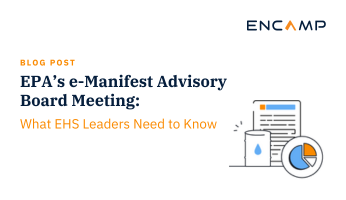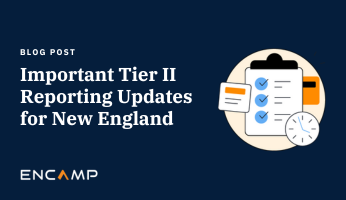Credible and trustworthy data is central to an organization’s environmental compliance. Every day. Because for hazardous chemicals, hazardous waste, or both, state and local regulations don’t allow days off. The risk of disastrous events and the potential impact to the community and environment is too high — and too constant.
In line with a business’s compliance program areas and Tier II reporting requirements, compliance information must therefore be consistently up to date, validated, complete, and accurate. Which means monitoring and collecting relevant data should be a continuous effort, right?
Unfortunately for many EHS operations, continuous data collection isn’t always doable, for notable reasons: Multiple facilities, often in different states. A shortage of trained EHS staff, particularly at the facility level, where non-EHS employees are forced to handle compliance tasks they’re not familiar with. But the biggest roadblock for gathering data is scattered data sources, the lack of a central database, and no established information flows or pipelines.
The result is that data needed for environmental compliance isn’t always available. And when it isn’t, it can invite non-compliance and potentially costly penalties and reputational damage.
Achieving Continuous Environmental Compliance
A much stronger safeguard for environmental compliance is to build a centralized compliance foundation to manage and monitor data in one place — continually. Equally vital is a continuous data collection process tied to the compliance foundation you establish. The purpose of these measures is twofold:
- Businesses and their EHS teams drive continuous environmental compliance via a single source of truth specific to applicable program areas, and
- Should the business scale and add or acquire facilities, a compliance foundation’s course of persistent data collection and improved data management, quality, visibility, and control supports growth and continuous environmental compliance accordingly.
These measures are also the first two steps of Encamp’s Guided Environmental Compliance method, which additionally introduces digital transformation to compliance data management and the reporting process.
From our experts: “Technology and best practices must work together”
Although technology plays a key role in achieving continuous environmental compliance, best practices for data collection and building your respective compliance foundations are just as key. No one knows this better than Megan Walters, VP of Compliance & Customer Success at Encamp, and Eugene Simonds, Encamp’s Compliance Program Manager. They discuss the uppermost best practices for continuous environmental compliance in the sections that follow.
Establish your environmental compliance foundations
Without sound compliance foundations for your company’s program areas, according to Megan, the biggest problem for environmental compliance and reporting is poor data quality. The accuracy of information suffers due largely to data not being fully visible and monitored on a continuous basis. Subsequently, compliance reports that are inaccurate or incomplete because of unchecked or unvalidated data pose glaring risks for non-compliance — and for the financial, operational and reputational penalties that can come with it.
A worse outcome is that leaders across the organization begin to question whether environmental compliance efforts are able to meet the requirements of federal, state and local regulatory agencies.
Building a reliable compliance foundation for each regulatory program area, whether EPCRA, RCRA, the Clean Air Act, or the Clean Water Act, should therefore become a priority for compliance operations. This is also a first step towards environmental digital transformation.
Where technology and environmental digital transformation comes in
“Within a given compliance foundation, data should consist of all existing corporate, facility, and personnel information relating to that program area,” Eugene said. “Data should also be organized in a way that’s readily visible and available to those who need it, enterprise-wide.”
Technology and environmental digital transformation come into play here in the form of digitized data and a single centralized system for managing compliance information. (Encamp is such a unified data system). When data is organized in one centralized location, the unified system serves as your organization’s single source of truth for compliance operations and continual environmental compliance alike. Within the system, digitized data is additionally more visible and easier to manage electronically.
For data collection and establishing a compliance foundation, Megan suggests making these best practices a staple of your compliance program:
- Collect corporate, facility, and personnel information relating to each program area. Maintaining up-to-date contact (personnel) info for each facility is particularly important, in that local authorities and first responders must be able to reach the appropriate contact should a hazardous event occur at that site.
- Establish a schedule, as well as reminders, to regularly check information for updates.
- Along with a regular schedule to verify information, develop and implement a change management process for business continuity. When people leave or compliance and reporting functions change, such a process lets others know what info to update.
For a centralized data system, also consider the various data it should house. According to Eugene, key data for continuous environmental compliance should include:
- Facility profiles, which can be built out via the data system
- Regulatory contacts, including SERCs, LEPCs, and local fire departments
- Environmental permits
- Material inventory, such as chemical inventory lists
- Waste profiles
- Safety data sheets
(Note that when Encamp is your chosen data system, a dedicated Encamp Customer Success Manager (CSM) works with your environmental compliance and operations teams to collect existing data during initial onboarding. Centralizing data into the single Encamp portal then sets the tone for the system to become your compliance foundation for a particular program area.)
Greater control of environmental compliance information
“The premise of any unified data system and centralizing environmental compliance information is to increase control of your data, both in collecting it and in building compliance foundations,“ Eugene added. Encamp is built on this premise, and even extends control to being able to push compliance data to all relevant regulatory databases at a state or federal level. Completing this critical step means you no longer need to manually access or update information in individual state and federal systems, which can be especially time-consuming.
For new facilities, scalability and best practices are built in
If your organization adds facilities (whether through company growth or acquisition), it’s important to have a robust and flexible system that scales and correspondingly makes changes to your compliance foundation, including all places in which data lives at a state and federal level. As an inherent change management system for all new sites, your environmental compliance operations are able to:
- Change emergency contact(s)
- Change the corporate mailing address and update other associated information
- Centrally log changes or updates as they’re made
Technology research firm Gartner predicts that in 2022, 70% of organizations will rigorously track data quality levels, improving quality by as much as 60% to significantly reduce operational risks and costs.
Establish continuous data collection
“Collecting data for environmental compliance purposes is hard enough as it is” as Eugene also pointed out. “But when data lives in different locations such as spreadsheets and separate databases, information is harder to obtain in a sustained manner.” For compliance foundations and continual environmental compliance, this makes creating a constant, real-time data monitoring and collection process all the more critical.
Eugene’s recommended top best practices to establish data collection on a continuous basis are to:
- Determine an appropriate collection cadence — and then stick to it. Depending on the volume of compliance data for a specific program area, a cadence can be daily, weekly, monthly, or longer. If facility counts and data volumes increase, consider also increasing data collection frequencies as needed to maintain consistent collection streams and data ingestion.
- Work with compliance leaders to establish and maintain relevant, ongoing data channels. These pipelines can include direct uploads, integrations to existing data systems (when possible), and even digital questionnaires completed by facility personnel.
- Consider every possible occurrence in which data is collected: purchase records, waste shipments, waste determinations (sampling, etc.), inventory lists, and other occurrences.
- Standardize the data collection process and automate it wherever possible. (This is another aspect of environmental digital transformation.) When the data collection process is standardized, it becomes repeatable, sustainable, and often more efficient over time. It also lends to business continuity in that the process isn’t severely impacted by employee turnover or compliance staffing changes.
Whereas you once had countless spreadsheets being passed around via email and internal drives, establishing a continuous data monitoring and collection process allows all relevant compliance data for each program area to be collected in a systematic and largely automated manner.
“For environmental compliance in a continuous manner,” as Eugene said, “the end result is greater data visibility and control, with less effort and fewer errors.”
Standardizing the data collection process across all locations ensures that needed data is collected more accurately and in real time. According to a recent study, 66% of operations professionals cited automation as being key in reducing data errors.
Transforming the way enterprises stay in compliance
Encamp is on a mission to create a world where good for business can equal good for the environment. We help enterprises transform compliance programs and human processes into a technology-driven system that lays the foundation for accurate and ongoing environmental compliance through a blended method of intelligent high-tech solutions and high-touch expert support.
Tom Bailey
Tom is the Senior Content Writer at Encamp. And like all other Encampers, he’s in tune with the environment and what happens to it. He’s been writing about creative technology solutions for longer than he cares to admit.



